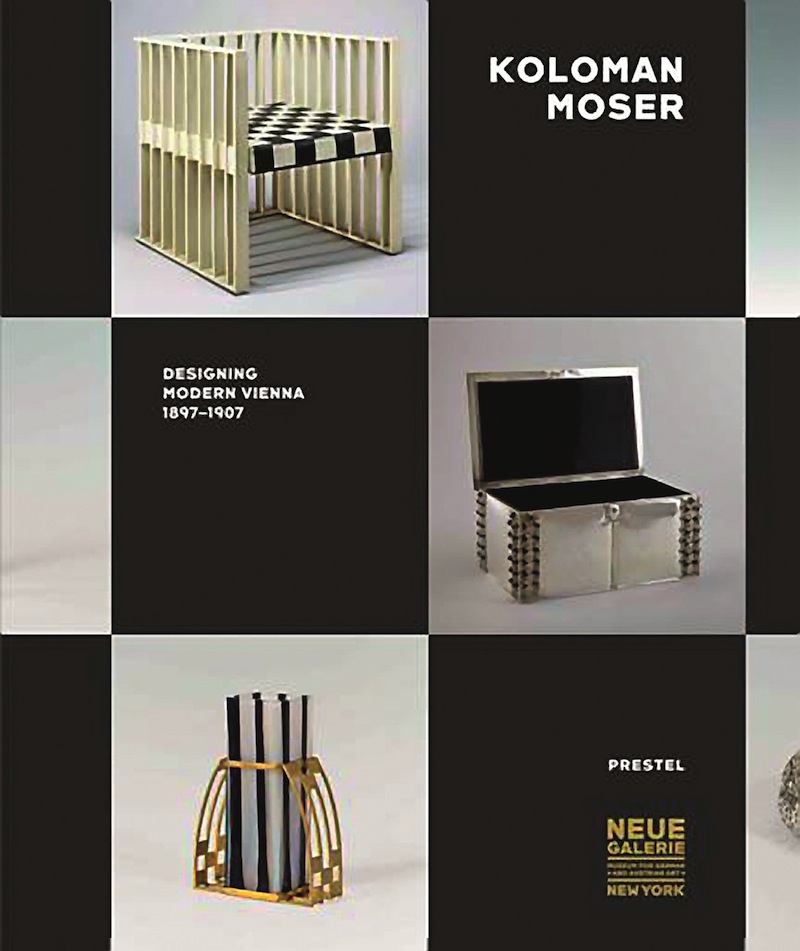Koloman Moser: Designing Modern Vienna 1897-1907
Edited by Christian Witt-Dörring
Prestle Publishing with the Neue Galerie New York, 2013
With a preface from Renée Price, contributions from Christian Witt-Dörring, Angela Völker, Janis Staggs, Ernst Ploil, Elisabeth Schmuttermeier and Rainald Franz, and a preface from Ronald S. Lauder
Hardcover, linen with jacket, 400 pages. 400 color illustrations, 70 b/w illustrations. 9.3 x 11.2 inches
Koloman Moser: Designing Modern Vienna 1897-1907 is simply stunning. Moser’s body of work is as impressive as it is varied and the book lives up to the challenge of fully documenting the most productive period of his life. Dr. Christian Witt-Dörring, the Curator of Decorative Arts for the Neue Galerie, edited the book in addition to curating the eponymous show at the Neue Galerie (May 23 – September 2, 2013). The exhibition was styled as an immersive environment intended to capture the Viennese ideal of the Gesamtkunstwerk, or total work of art, encompassing Moser’s decorative arts career, interior design commissions, and examples of his graphic design, furniture, textiles, jewelry, metalwork, glass, and ceramics of that period. The book is richly flavored with preparatory drawings and documentation of the holistic nature of Moser’s work, in addition to astute texts and luscious photography of the artwork itself.
The book’s only failing is that it skimps on Moser’s ceramic work. Given the tremendous amount of ground that it does cover and how gloriously it illuminates Moser’s brilliant, under recognized career, this can be forgiven. At 400 pages that are all wheat and no chaff, Witt-Dörring’s monograph is a Gesamtkunstwerk in its own right.
Koloman Moser was born in Vienna in 1868. He studied at Vienna’s Akademie der bildenden Künste (Academy of Fine Arts) and the Kunstgewerbeschule (School of Applied Arts), where he met Josef Hoffmann and many other artists who later formed the Vienna Secession movement. His designs in architecture, furniture, jewelry, graphics, and tapestries helped characterize the work of this era. Moser drew upon the clean lines and repetitive motifs of classical Greek and Roman art and architecture in reaction to the Baroque decadence of his turn-of-the-century Viennese surroundings. In 1900, Moser was named a full professor at the Kunstgewerbeschule, where he taught decorative drawing and painting until his death at the age of 50.
Aside from a lavish biography and further appendices, the book is divided into five primary chapters: “Graphic Art,” “Interiors and Furniture,” “Textile, Fashion, and Theater Costumes,” “Glass and Ceramics,” and “The Wiener Werkstätte.” Moser’s most lasting legacy may be his seminal role as co-founder of the Wiener Werkstätte (Vienna Workshops), the applied arts collective he formed with Josef Hoffmann and patron Fritz Waerndorfer in May 1903.
In his insightful review of the exhibition in the New York Times (June 6, 2013), Ken Johnson makes a compelling case for Koloman Mosner’s relevance:
It seems no kind of domestic ware was too trivial for Moser to put his stamp on. He knew that the beauty of the Gesamtkunstwerk had to be as much in the details as in the whole.
Considering how much he produced, it’s surprising how short-lived was Moser’s involvement with the Wiener Werkstätte. In 1907, frustrated by the demands of clients and by mismanagement of the organization’s finances, he resigned and devoted the last decade of his life to painting, in which occupation he was not nearly as original judging by a single small, nondescript still life from 1907 included in the show.
Today the business of luxury interior design thrives as never before. But if it has anything like the soulful passion that animated Moser and his collaborators, it’s a well-guarded secret.
We are all familiar with the handful of contemporary, international “super designers” who seem to do it all, in some cases, the number of objects that they churn out can only be explained by a need to put their “brand” on everything imaginable. Mosner’s work is the real deal—which is always timely.
Koloman Moser: Designing Modern Vienna 1897-1907, the exhibition, is currently on show at the Museum of Fine Arts, Houston until January 12, 2014, so you still have a chance to see it. Whether or not you see the show, you will want to own this monograph.
Amy Albracht is the General Editor of CFile.


Spreads from Koloman Moser: Designing Modern Vienna 1897-1907
Read Ken Johnson’s review of the exhibition in The New York Times

Dear Amy,
Thanks for the great review !
Bill